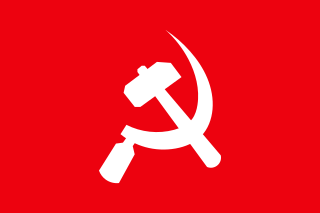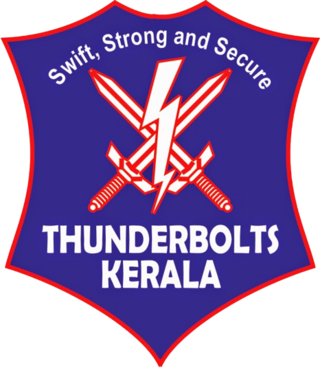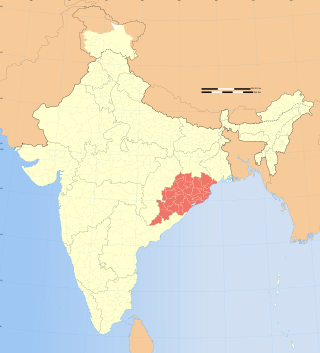Related Research Articles

The Communist Party of India (Maoist) is a Marxist–Leninist–Maoist banned communist political party and militant organization in India which aims to overthrow the "semi-colonial and semi-feudal Indian state" through protracted people's war. It was founded on 21 September 2004, through the merger of the Communist Party of India (Marxist–Leninist) People's War (People's War Group) and the Maoist Communist Centre of India (MCCI). The party has been designated as a terrorist organisation in India under the Unlawful Activities (Prevention) Act since 2009.

Koraput district is a district of India in southern Odisha, with headquarters at Koraput. The district is located in the Eastern Ghats and is known for its hilly terrain, rich and diverse types of mineral deposits and its tribal culture and traditions. The district headquarters town of Koraput and its largest city, Jeypore are major centres of trade and commerce for South Odisha and fall on an important road connecting Visakhapatnam to Raipur.
Malkangiri, historically known as Malikamardhangiri, is a town and municipality in Malkangiri district in the Indian state of Odisha. It is the headquarter of the Malkangiri district. Malkangiri has been the new home of the East Bengali refugees from erstwhile East Pakistan, who have been rehabilitated since 1965 under the Dandakaranya Project. Some Sri Lankan Tamil refugees were also rehabilitated in the town, following the armed struggle of the Liberation Tigers of Tamil Eelam (LTTE) in the early 1990s, although most of them have now returned to their country. Currently, it is one of the most naxalite-affected areas of the state, and is a part of the Red Corridor.

Malkangiri district is the southwesternmost district in the Indian state of Odisha. It has two Vidhan sabha constituencies.

The Naxalite–Maoist insurgency is an ongoing conflict between Maoist groups known as Naxalites or Naxals and the Indian government. The influence zone of the Naxalites is called the red corridor, which has been steadily declining in terms of geographical coverage and number of violent incidents, and in 2021 it was confined to the 25 "most affected" locations, accounting for 85% of Left Wing Extremism (LWE) violence, and 70 "total affected" districts across 10 states in two coal-rich, remote, forested hilly clusters in and around the Dandakaranya-Chhattisgarh-Odisha region and the tri-junction area of Jharkhand-Bihar and-West Bengal. The Naxalites have frequently targeted police and government workers in what they say is a fight for improved land rights and more jobs for neglected agricultural labourers and the poor.

COBRA is a special operation unit of the Central Reserve Police Force (CRPF) of India proficient in guerrilla tactics and jungle warfare. Originally established to counter the Naxalite movement, CoBRA is deployed to address insurgent groups engaging in asymmetrical warfare. Numbering ten battalions as of 2011, CoBRA is considered to be one of the most experienced and successful law enforcement units in the country.

The Odisha Police abbreviated as either OP or OPS, is the law enforcement agency for the state of Odisha in India. It is headquartered in Cuttack, the former capital of Odisha. The Odisha Police is headed by a Director General of Police, currently Sunil Kumar Bansal, IPS and falls under the purview of the state's Home Department of the Government of Odisha. The sanctioned personnel strength of Odisha Police is 72,145; comprising women as one-third of it total sanctioned strength in the directly recruited posts of civil constable, sub-inspector and deputy superintendent of police. This feat makes it one of the foremost in that aspect among the police services of India.
This is a timeline of the 1967–present Naxalite–Maoist insurgency in eastern India.
The Special Operations Group is a 2300+-strong elite anti-insurgency force chosen from more than 100,000 troopers of the Jammu and Kashmir Police. The J&K police has since been very competent and on the frontlines in anti-terror activities. The SOG members are also the first targets of the militant groups and local separatists alike.
Operation Green Hunt is the name used by the Indian media to describe the "all-out offensive by paramilitary forces and the states forces" against the Naxalites. The operation is believed to have begun in November 2009 along five states in the "Red Corridor."

Greyhounds is a police special forces unit of the Andhra Pradesh and Telangana Police departments in India. Greyhounds specialises in counter-insurgency operations against Naxalite and Maoist terrorists.

Swayamsiddha is a 2010 Odia film directed by Sudhanshu Sahu with a screenplay and dialogue by Dilip Choudhury, produced by Prabhat Ranjan Mallik, and starring Siddhanta Mahapatra and Yukta Inderlal Mookhey. The film focuses on the implications for the young mass adopting to Maoist insurgency and their sustained alienation from the mainstream as a result. Geo-strategic importance of changing the minds of young people adopting terrorism through love and affection. The film traces the crisis from social trauma to unfair state system encouraging Mao-Naxal insurgency in Odisha.
The State Armed Police Forces of India are the police units established for dealing with serious law and order situations requiring a higher level of armed expertise than normal. The State Armed Police Forces exist in addition to the ordinary police services of the various states.

Kerala Thunderbolts is an elite commando force of the Kerala Police under the India Reserve Battalion, set up in accordance with the Indian central government's directions post the 2008 Mumbai attacks. The commando force has been created to counter possible terror strikes and carry out counterinsurgency operations in Kerala. The force modeled on the Special Protection Group and National Security Guard are trained to engage in air, water and land attacks.

The Jharsuguda–Vizianagaram line is a railway line in eastern India. It connects Jharsuguda,516 km (321 mi) from Howrah on the Howrah–Nagpur–Mumbai line, and Titlagarh, which in turn is connected with Vizianagaram, 820 km (510 mi) from Howrah on the Howrah–Chennai main line, and Raipur Junction, 830 km (516 mi) from Howrah on the Howrah–Nagpur–Mumbai line. There are several branch lines, like the 176 km (109 mi) line connecting Rayagada with Koraput on the Kothavalasa–Kirandul line. The line traverses Western Odisha and connects the Howrah–Nagpur–Mumbai line with the Howrah–Chennai main line. It covers small portions of Chhattisgarh and Andhra Pradesh.
On 25 May 2013, Naxalite insurgents of the Communist Party of India (Maoist) attacked a convoy of Indian National Congress leaders in the Jhiram Ghati, Darbha Valley in the Sukma district of Chhattisgarh, India. The attack caused at least 27 deaths, including that of former state minister Mahendra Karma and Chhattisgarh Congress chief Nand Kumar Patel. Vidya Charan Shukla, a senior Congress leader, succumbed to his injuries on 11 June 2013.
The Special Tactical Unit (STU) is an urban counter terrorist unit of the Odisha Police in Odisha, India. They specialise in urban warfare scenarios including hostage situations.

The Special Operation Group (SOG) is an elite Commando unit raised by the Odisha Police to combat the Left Wing extremists in Odisha. They also have a small group that can carry out other counter-terrorist operations like hostage situation and building intervention. The force specializes in jungle warfare and have been hugely successful in controlling violence by armed guerillas of the Left Wing extremist groups, more popularly called 'Naxalites' in India.
The Dandakaranya Project, or the DNK Project, was the form of action the Indian government designed in September 1958 for the settlement of displaced persons from Bangladesh and for integrated development of the area with particular regard to the promotion of the interests of the local tribal population. The particular focus was on Bengali refugees from East Pakistan moving to lands and resources in Odisha and Chhattisgarh. To implement this project, the Government of India established the Dandakaranya Development Authority.
Constable Debashish Sethy, SC was an Indian Police Constable of the Odisha Police's Special Operations Group (SOG) who was posthumously conferred India's third highest peacetime gallantry award, the Shaurya Chakra.
References
- 1 2 "Small force that provides the cutting edge". The Indian Express . 16 September 2013. Retrieved 20 February 2015.
- ↑ "State to enhance anti-Red strength". The Telegraph (India) . 15 January 2011. Archived from the original on 21 February 2015. Retrieved 21 February 2015.
- ↑ "Two Maoists gunned down in Orissa". The Indian Express . 5 March 2014. Retrieved 21 February 2015.
- ↑ "Maoist shot dead in encounter in Odisha". Zee News . 14 May 2014. Retrieved 21 February 2015.
- ↑ "Maoist nabbed in Malkangiri". The Hindu . 19 September 2014. Retrieved 21 February 2015.
- ↑ "Two maoists arrested in Sambalpur". Jagran . 31 December 2014. Retrieved 21 February 2015.